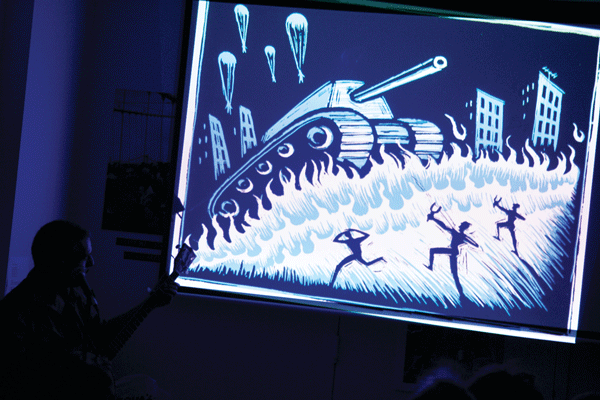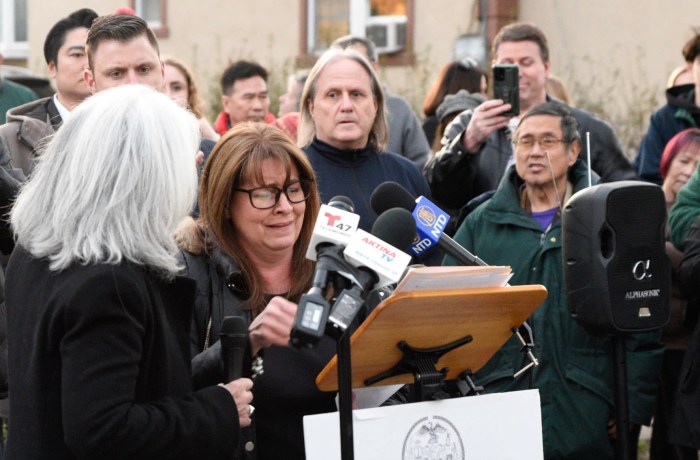
BY LINCOLN ANDERSON | Shortly before Superstorm Sandy slammed New York, the new Museum of Reclaimed Open Space hosted Eric Drooker for an evening of art, music and conversation.
Four days later, the newly renovated basement of the activist museum, at 10th St. and Avenue C, was awash with 6 feet of water, setting back MoRUS’s planned Nov. 17 opening.
The grand opening is now set for Sat., Dec. 8. At 3 p.m., Councilmember Rosie Mendez is scheduled to lead a chain-cutting ceremony.
Afterward, there will be presentations and talks by legendary neighborhood activists and artists, including Adam Purple, Seth Tobocman, Fly, Peter Missing, Ben Shepard and Frank Morales, as well Reverend Billy and The Church of Stop Shopping and members of the Bread and Puppet Theater.
At 8 p.m., the Rude Mechanical Orchestra will lead a march, and there will be a grand opening party, also at 8 p.m., with music by DJ Dirty Finger and RMO, plus food and drinks.
As for Drooker’s presentation, he spoke about growing up in the East Village and developing an early interest in drawing. He recalled as a kid seeing a curious, bushy-bearded figure, Allen Ginsberg, on the neighborhood’s streets, and, as Drooker grew up, he learned about him. The first time they really hung out together was Aug. 6, 1988, during the Tompkins Square riot.
Having seen Drooker’s posters around the neighborhood, Ginsberg asked if he’d like to collaborate on a work, and this led to several joint efforts, with Drooker putting images to Ginsberg’s words.
Drooker went on to move to the West Coast and score numerous covers for The New Yorker. The key to breaking into mainstream illustration, he explained, while showing slides of some of his stunning New Yorker covers, is “make it really, really beautiful and really, really funny.”
Then the day came when, to his surprise, Drooker was asked to illustrate Ginsberg’s “HOWL” — one of the Beat movement’s defining works — for the movie starring James Franco as the iconoclastic poet.
“I thought, ‘Are you high on crack?’” Drooker recalled of his first reaction. “Illustrate ‘HOWL’? Why not illustrate Dante’s ‘Inferno’?… Trying to translate the poem into images took me a couple of years.”
He didn’t do the moving animation, but sent still images — with instructions on how he envisioned the action — to a studio in Asia, which, he noted, did a surprisingly good job with it.
Discussing how he creates, he said it’s important for him to spend an hour a day outside walking around, “just to experience reality, to see what’s going on.” Computers are a new challenge, though, anchoring people inside.
“We’re in a very dangerous time in our culture where we may have lost the ability to go outside,” he warned. “It’s hazardous for an artist or writer — anyone who spends a lot of time alone — being in an ivory tower.”
Clearly, though, Drooker gets around. He showed photos from a recent trip to Gaza, where he hung out with Palestinian kids and helped them create artwork on the side of the Israeli separation wall.
During his talk, he accompanied himself at times on a banjo and a harmonica, and concluded by singing a blues song.
“I think this is going to give the Tenement Musem a run for their money — it’s a living museum,” he said of MoRUS.
Bill Di Paola and Laurie Mittelmann, the museum’s co-directors, said of Drooker’s presentation, “We were very happy to host Eric’s community slideshow. Eric was born in the neighborhood and has always been a big supporter of community activism.”

















